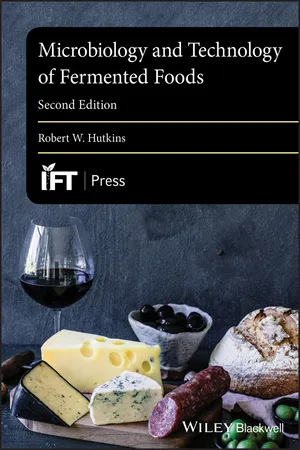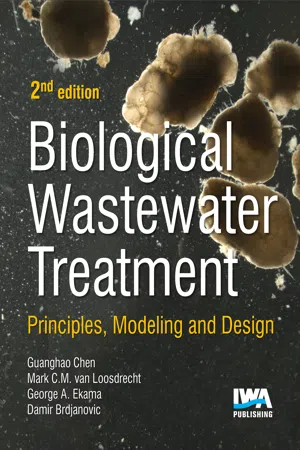Biological Sciences
Bacterial Metabolism
Bacterial metabolism refers to the chemical processes that occur within bacteria to maintain life. It involves the conversion of nutrients into energy, the synthesis of cellular components, and the elimination of waste products. Bacterial metabolism can be categorized into different pathways, such as glycolysis, the citric acid cycle, and oxidative phosphorylation, which play crucial roles in the survival and growth of bacteria.
Written by Perlego with AI-assistance
Related key terms
6 Key excerpts on "Bacterial Metabolism"
- eBook - ePub
- Rene Krata(Author)
- 2011(Publication Date)
- Barrons Educational Series(Publisher)
5Microbial Metabolism WHAT YOU WILL LEARNThis chapter introduces the fundamentals of metabolism, especially as they apply to microbial cells. As you study this chapter, you will: • learn about the ways humans use microbial metabolism; • review how cells transfer energy and electrons; • explore the process of cellular respiration; • compare cellular respiration and fermentation; • discover how microbes make food by photosynthesis and chemolithoautotrophy.SECTIONS IN THIS CHAPTER• Fundamentals of Metabolism• An Overview of Microbial Metabolism• Fundamental Metabolic Pathways of Heterotrophic Metabolism• Fundamental Metabolic Pathways of Autotrophic Metabolism• Anabolic PathwaysCells, whether yours or a microbe’s, are living, growing things. They require energy and materials that can be used as building blocks. We feed our cells by taking food into our mouths and then breaking it down in our digestive system. Once the food is broken down into protein, carbohydrate, and fat molecules, our cells can take in those molecules and use them. Similarly, the cells of microbes may take in food molecules from their environment. If the cells break the molecules down further in order to obtain energy, it is called catabolism . If a cell uses a molecule as a building block to make a larger molecule, it is called anabolism . All of these processes together, the breaking down and the building up, is called metabolism .Metabolism is an amazing thing. At any one time, a cell is performing hundreds of different chemical reactions, breaking down molecules for energy and building molecules it needs to do certain jobs. And when we look at all the types of life on planet Earth, the metabolic champions are the microbes. As a group, microbes are incredibly diverse in their metabolism. They can break down more types of molecules than any other group and produce many different types of molecules as waste.This metabolic diversity of microbes has been used by humans since ancient times. Anything you’ve ever eaten that’s been fermented, like yogurt, wine, or beer, was made with microbial metabolism. Breads and cheeses too require the action of microbes, as do soy sauce, kim chee, sausages, sauerkraut, and kefir. Our use of microbial metabolism goes beyond food. We use microbes to clean up our sewage and other types of pollution like oil spills. In the future, we may be able to make plastics that microbes can eat, eliminating a problem substance in our landfills. Microbes also produce enzymes that are used in laundry detergents and to make products like paper and corn syrup. Microbes make vitamins and are a source of the amino acids used to make artificial sweeteners (aspartame) and MSG. Recently, we’ve even begun to modify microbes by introducing pieces of DNA so that they can make human proteins like insulin and interferon that are used to fight disease. - Jason Birkett, John Lester(Authors)
- 2018(Publication Date)
- CRC Press(Publisher)
Chapter 9Microbial metabolism
9.1 Introduction
A living cell, in order to survive, grow and reproduce, has two absolute requirements. These are an external source of carbon (termed the substrate) which is assimilated and used to make new cellular material, and a source of energy which is converted and utilized in the synthesis of this material. A third requirement is for reducing power. This requirement is variable, depending on the particular mode of metabolism possessed by the organism. In the case of autotrophs, whose source of carbon is carbon dioxide, the requirements for energy and reducing power involved in the synthesis of, say, a large polysaccharide are considerable indeed. These major requirements and their relationships to biosynthetic processes are shown schematically in Fig. 9.1 . This chapter is concerned predominantly with those processes which appear on the left of Fig. 9.1 and which are involved in the degradation of the substrate and the abstraction of energy. These processes are collectively termed catabolism. A brief discussion of the anabolic processes involved in the synthesis of biological macromolecules is included in Section 9.4.Figure 9.1 also indicates that there are intermediate stages between the primary sources and their ultimate utilization in anabolic processes. These intermediate stages are of importance in allowing a degree of flexibility and control in the cell’s utilization of energy. The existence of reservoirs for energy and reducing power permits the dissociation of energy-yielding metabolism and energy-consuming metabolism on both a temporal and a spatial basis.The first part of this chapter examines the mechanisms whereby energy transfer occurs in metabolic reactions. Before considering the biochemical aspects of this, however, it is necessary to examine the nature of the driving force which makes chemical reactions occur, the associated energy changes involved (thermodynamics), and how these contribute to establishing the extent to which the reaction occurs (chemical equilibrium).- eBook - ePub
- Tyrrell Conway, Paul S. Cohen(Authors)
- 2015(Publication Date)
- ASM Press(Publisher)
3 Metabolic Adaptations of Intracellullar Bacterial Pathogens and their Mammalian Host Cells during Infection (“Pathometabolism”) WOLFGANG EISENREICH, 1 JÜRGEN HEESEMANN, 2 THOMAS RUDEL, 3 and WERNER GOEBEL 2 Metabolic adaptation reactions are common when prokaryotes interact with eukaryotic cells, especially when the bacteria are internalized by these host cells. Such adaptations lead to significant changes in the metabolism of both partners. While the final outcome may be sometimes beneficial (e.g., in case of insect endosymbiosis) or (mainly) neutral for the interacting partners (e.g., microbiota and their hosts) (1 – 3), it is usually detrimental in infections of mammalian cells by intracellular bacterial pathogens. In this encounter, a host cell-defense program is initiated, including antimicrobial metabolic reactions aimed to damage the invading pathogen and/or to withdraw essential nutrients, while the intracellular pathogen tries to deprive nutrients from the host cell and to counteract the antimicrobial reactions, resulting in damaging of the host cell. Our knowledge of the metabolic adaptation processes occurring during this liaison and the link between these metabolic changes and the pathogenicity is still rather fragmentary. For these complex metabolic interactions, we coin the term “pathometabolism” - eBook - ePub
- Robert W. Hutkins(Author)
- 2018(Publication Date)
- Wiley-Blackwell(Publisher)
For the microorganisms that actually perform fermentations, the process is merely the means by which they obtain energy or satisfy their nitrogen or carbon requirements. Microorganisms, after all, need energy to perform work (e.g., nutrient transport and biosynthesis), to maintain chemical and physical homeostasis (e.g., ionic and osmotic), and to grow and replicate. For the most part, the energy generated by fermentation is in the form of ATP, and usually it is produced via metabolism of sugars (although, exceptions, as suggested above, for both of these claims exist). Whether metabolism by microorganisms also results in the conversion of milk into yogurt or juice into wine is of no concern to the organism. Indeed, the same metabolic pathway may also lead to formation of end‐products that cause milk or juice to become spoiled, which matters little to the offending organism. However, these outcomes do matter to yogurt and wine manufacturers. Knowing how to control and manipulate microorganisms and their metabolic activities can mean the difference between a pleasant‐tasting container of yogurt or soured milk that is tossed down the drain, between success and failure, and between profit and loss. Therefore, understanding the biochemical basis for metabolism of sugars, as well as other substrates, is essential for consistent production of fermented foods having the expected biological, physical, chemical, nutritional, and sensory characteristics.SUGAR METABOLISM
Fermentation biochemistry and microbial physiology were first studied by Pasteur, Buchner, Schwann, and other early microbiologists and biochemists. That food‐related sugar fermentations, in particular, had attracted the attention of these scientists was actually quite reasonable. After all, fermented milk products, beer, and wine were culturally and industrially‐important products whose manufacture depended on fermentation of sugars by microorganisms. Thus, identifying the organisms and pathways was essential to understanding how the manufacture of these products could be controlled or improved and to prevent or delay spoilage. In the sections to follow, metabolism and transport of sugars by lactic acid bacteria and ethanol‐producing yeasts will be reviewed.Homofermentation
Lactic acid bacteria are, in general, obligate fermentors, and do not obtain energy by oxidative or respiratory processes, albeit with one major exception (Box - eBook - ePub
- M. Bazin(Author)
- 2018(Publication Date)
- CRC Press(Publisher)
c . Nevertheless, the use of known biochemical pathways to describe bacterial growth is in principle an attractive approach because it ultimately aims at connecting all biochemical events at the molecular level. From there on, insight into the energetics of this process could be gained.The question of whether the practical observation that we obtain fewer cells than expected from the growth substrate is due to impaired energy generation, energy spilling, or poor coupling between ATP hydrolysis and biosynthesis may seem a semantic one from the standpoint of biochemical bookkeeping. However, it brings to light an important difference between the description using yield factors and the MNET approach. The latter has the potential to discriminate between the three main fluxes when their respective stoichiometric constants are changing. By studying the metabolic changes and the various growth parameters, we may experimentally decide with the equations given earlier what role a given catabolic or anabolic pathway plays in the overall metabolism of a bacterial cell.In order to meet the prerequisite of being a model, i.e., provide us with an insight into the events taking place and their interrelationships, both the MNET and the biochemical descriptions have to introduce simplifications. A very important and questionable assumption in both approaches is that the cell is considered as a unit of constant composition and expressing constant enzyme activities at different growth rates. We know that in general this assumption is not valid. Unfortunately, incorporating the dependency of cell composition on growth rate deprives the biochemical description from most of its value: for each new growth condition the cell composition would have to be determined. Incorporating the variable enzyme activities in the MNET description (e.g., by varying the values of L with growth rate) is not impossible, but will certainly lead to more complex equations. - eBook - ePub
- G. H. Chen, Mark C. M. Loosdrecht, G. A. Ekama, Damir Brdjanovic(Authors)
- 2020(Publication Date)
- IWA Publishing(Publisher)
−). The chemical energy contained in e-donors is transformed into a usable form for the microorganism. A membrane process is involved in converting the biochemical (redox) energy into adenosine triphosphate (ATP), the intracellular chemical energy transporter. ATP is used to drive cellular maintenance and growth. Catabolic reactions run via three main pathways: aerobic and anaerobic respirations, and fermentation.Respiration pathways involve glycolysis, the Krebs cycle (or citric acid cycle, tricarboxylic acids cycle (TCA)), and the electron transport chain. Carbohydrate monomers are converted through glycolysis into pyruvate as the central intermediate. This oxidative process leads to the formation of ATP by substrate-level phosphorylation and of electrons carried by nicotinamide adenine dinucleotide (NADH). The dissimilation of organic compounds goes from pyruvate to acetyl-CoA to intermediate compounds of the Krebs cycle. Across glycolysis and the Krebs cycle, electrons are liberated and captured by NAD+ reduced into NADH. NADH delivers the electrons to the electron transport chain until release on the terminal e-acceptor (e.g. O2 ). This cellular respiration process activates the oxidative phosphorylation of adenosine diphosphate (ADP) into ATP. Both the electron transport chain and ATP biosynthesis occur in the cell membrane. These two processes are combined in a phenomenon called chemiosmosis. Three protein complexes are involved in the electron transport chain. They are proton pumps which generate a gradient of protons across the cell membrane. This proton gradient generates a proton-motive force which drives the ATP synthase.Aerobic respiration pathways involve O2 as terminal e-acceptor (i.e. respiration with air). Maximum three moles of ATP are produced per mole NADH oxidised at the electron transport chain. This is also expressed as a phosphate/oxygen (P/O) ratio of three moles of ATP produced per half mole of O2 used. In reality the P/O ratio is lower, between 1.5-2 moles ATP per half mole of O2
Learn about this page
Index pages curate the most relevant extracts from our library of academic textbooks. They’ve been created using an in-house natural language model (NLM), each adding context and meaning to key research topics.





